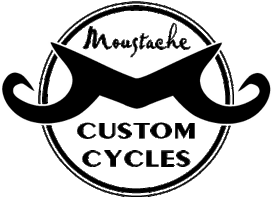I had to bust out the vegetable oil and the ol' camp stove in the shop the other day. Having the lathe around is awesome as it lets me work towards executing some ideas that have been back there for a while instead of just thinking about them. This is the first step in what will hopefully be a game changer in the bike packing world....at least for my customers. Paraffin is on the stove in the double boiler and the inside of the tapered steerer is oiled to allow the extraction of the mold.
With the molds extracted I can now see the exact inner profile of the tapered steerer and measure transferred IDs fairly accurately and match the taper angle on the lathe. Think back a little ways to the days of quill stem technology. Confused yet?
Having the lathe around has changed the way I look at recycling. Now its more like repurposing. This old Phil Wood front axle sitting in the trash was too good to pass up. Its already a nicely machined piece of aluminum, though stripped threads rendered it unsuitable for further bike duty.
The threaded ends were parted off and the shoulders cleaned up, the fat parts turned down to 15mm to make some truing stand adapters for thru axle front hubs. I should probably have thought to make the other side to 12mm, but since one of these hubs has yet to pass through my shop I just didn't think of it.
The Viking gave me this rusty old broken driveshaft of 2" OD. Solid steel and about 25 lbs in weight. Drilled a quick 15/16" hole down the length and got to work cleaning up the surface, turning some shoulders, and increasing that bore to 24mm.
With the shoulders accurately turned to provide a width of a shimano bottom bracket with appropriate (and unfortunate) plastic spacers, I now have a dummy BB for mock ups. This is for XT/SLX configurations and others that use that setup with the spacers. Road and Sram stuff would have to be configured differently. But no more threading and shoving to mock up the drive train and check for clearances.
The last one is just a part of solving a problem I've been trying to work out on the Henry James Jig for a while. I made the dummy tire from an old Jeep roll bar that's been sitting around the house since I moved here. The bigger problem is how to hold the stays, both chain and seat for accurate tacking. With the hand curved and hand mitered stays, fixturing them usually comes down to splitting the difference in the inconsistencies in the bends and cuts to where the eye can't tell if they're not exact. I've been using the bridge and boss jig to accomplish this fixturing along with some tubing blocks and a piece of half inch rod, but the mounting point of this aluminum arm is inherently flimsy and poorly toleranced. So if there's no great way to tell if it is centered, it makes the stay mock up out in space particularly difficult. The dummy tire is probably a step in the right direction, but really what's needed here is a solid arm from the main jig plate. Guess its time to buy a mill and start finding some aluminum block. The machine era sure is sweet though, and the practice projects here turning out functionally is good promise that the real upcoming projects will be a success.









